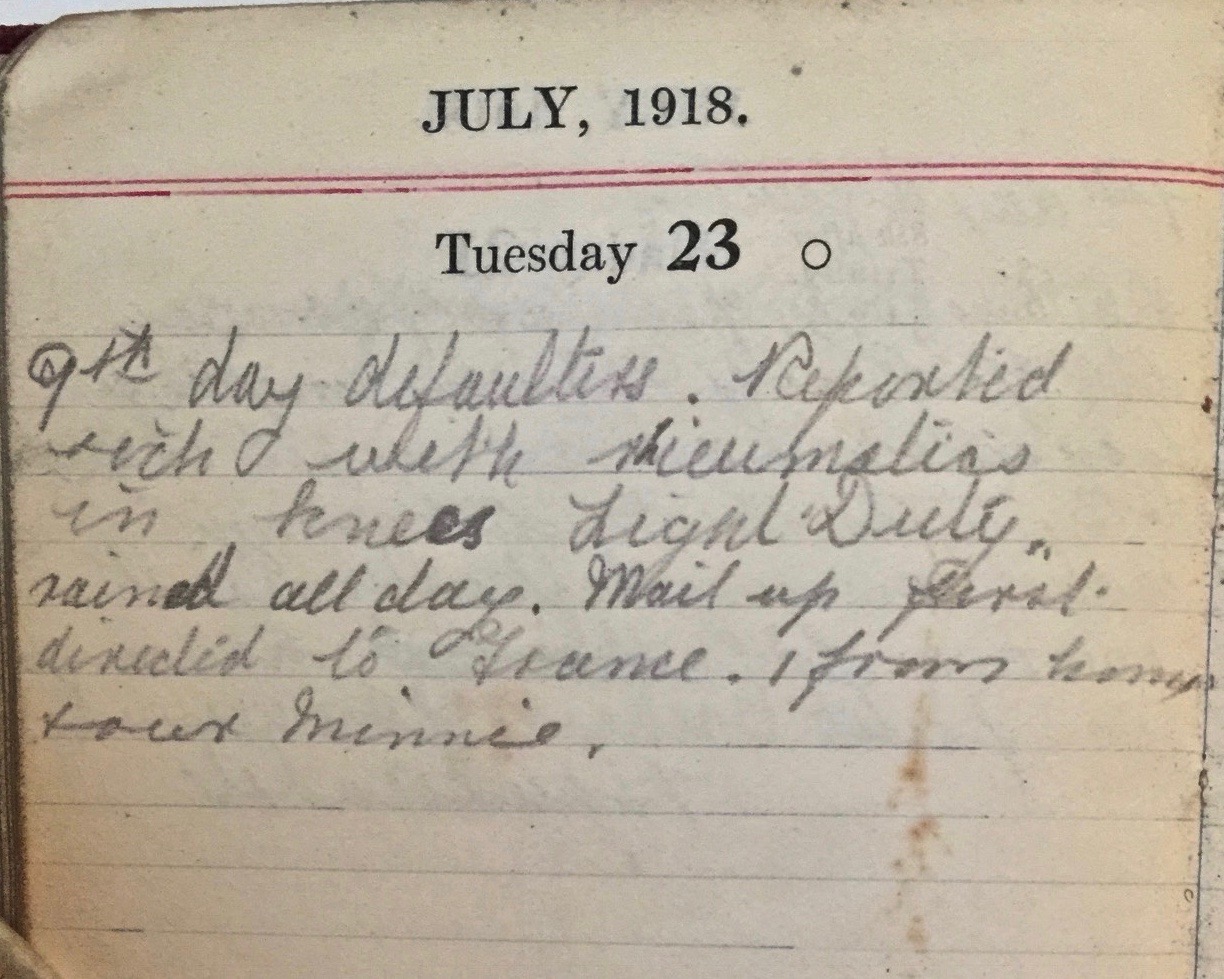Tuesday July 23rd, 1918
Ninth day defaulters. Reported sick with rheumatics in knees. Light duty. Rained all day. Mail up – first directed to France. One from home and our Minnie.
Letters from Home

Frank isn’t feeling well today and is given light duty. He is cheered by two letters, one from his wife, Sarah, and the other from his older sister, Minnie.
Minnie was born in 1871 and is married to William Greenhalgh. In the Census of 1901, he was listed as the caretaker at the Oddfellows Social Institute on Farrow Street in Crompton. The family lived on the premises. By the Census of 1911 however, he and two of his children were working in the cotton industry. The family had moved to Edmund Street in Shaw.
Their oldest son and Frank’s nephew, Harold, was in Salonika at the same time as Fr. Harold may either have served with the Manchester Regiment (35567) or the Lancashire Fusiliers (65597). Both regiments had battalions in Salonika and now in France.
Their youngest child, Bert, was born in 1900. Unless he has already volunteered, he will be conscripted this year.
The photograph of Minnie was taken when Frank was a baby – so probably in 1888 when she was 17 years old. It is cropped from a family snapshot.
The Oddfellows
This is a friendly society with a long history that still exists today. It was initial formed as the ‘Odd Fellows’ in the early 18th century to support worker members if they fell on hard times. The Odd Fellows represented craftsmen from a variety of trades – presumably leading to its name.
Friendly societies were outlawed for over fifty years from the 1790s – when such societies were perceived as hotbeds for revolution. It wasn’t until 1851 that they became legal in the UK. Thanks to the Industrial Revolution, ‘The Independent Order of Oddfellows Manchester Unity’ was the largest and richest of them.
By the turn of the 20th century, the Oddfellows had almost a million UK members, receipts of over £1.2 million annually and over £10 million capital. It also had affiliated lodges across the English-speaking world with a further 500,000 members.º
As reported in the Oddfellows Magazine of January 1901 by its Grand Master:
‘Whatever may be the ultimate verdict upon [the 19th] century, when its history comes to be written, it will be admitted to be a century of material advance, of strenuous activity, of fertility of invention by which the forces of nature have been harassed to the fuller use of man, of a more widely diffused prosperity, in which an ever-increasing number share many well-devised schemes for the amelioration of the social condition of the people. Prominent amongst the social schemes which have achieved so much will be placed the Friendly Societies. Their rise and progress are essentially of the nineteenth century.’¹
The Oddfellows in the Shaw District
In 1901/02, when the Greenhalgh’s were caretakers, Shaw District (including Royton, Heywood and Shaw & Crompton) had 8 lodges and over 1500 members. Four of these lodges used the Oddfellows’ Social Institute on Farrow Street as their meeting place. By 1914/15, membership had increased to over 1700 men and women. In addition one of the lodges had become a ‘Female Branch’ which numbered 133 women members. Men and women had equal rights.
The Oddfellows and War
Of the Boer War, still raging in early 1901, the Grand Master’s comments were to prove prophetic for the Great War:
’The prolongation of the campaign imposes further sacrifices on us as citizens and as members of the Manchester Unity – sacrifices which we feel assured will be cheerfully borne. The lodges continue to pay the contributions of those who are absent in South Africa engaged in their country’s service, and our funds continue to bear the heavy liability of sickness and wounds which must always accompany war. We do not disguise from ourselves that the latter will be much the more grievous liability. Men are returning home from South Africa enfeebled in health by the ravages of enteric and of dysentery – more insidious foes than the Boer bullets. It is to be feared that many of these victims of the war, young in years but broken in health will remind almost permanent burdens on the sick funds of their lodges.’¹
Between 1914 and 1918, the Oddfellows tried to live up to the ideals of their institution of the Boer War years. However the number of their members in service (over 200,000) and the casualties and suffering of over four years of war would necessitate some changes.
13th (Service) Battalion War Diary – 23rd July 1918 – Haudricourt, France
Specialist training and ?? For junior NCO. Remainder of the Battalion domestic fatigues putting up cookhouses etc. Training Program for week ending July 28th issued. Appendix No 2.
References & Further Reading
º The Oddfellows Magazine, June 1901, on the Oddfellows website
¹ The Oddfellows Magazine, January 1901, pages 5 & 6


